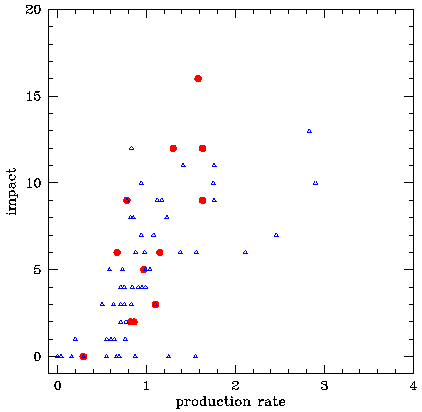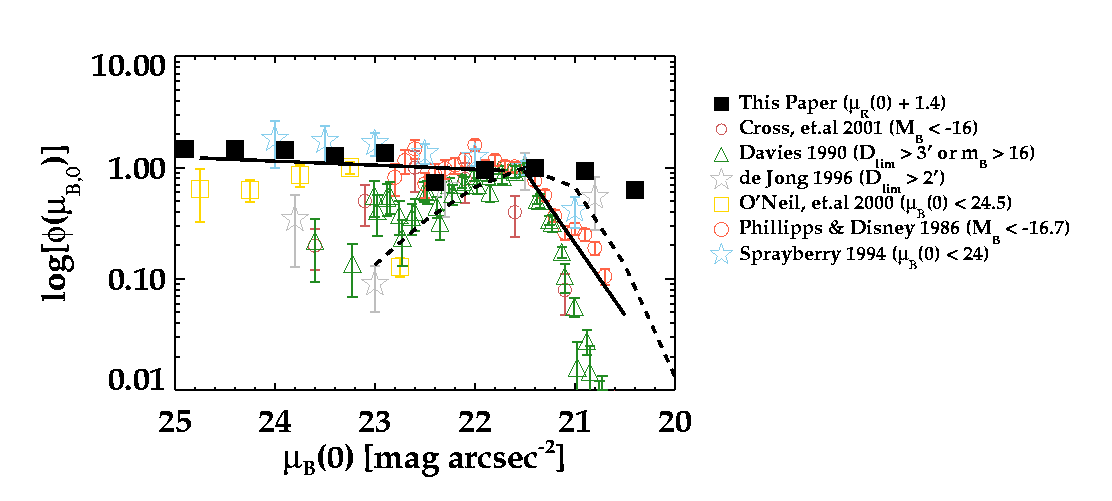News from MY Universe
2003 Dec 16: computed number of hits to my webpages
2003 Nov 18: a 2x2 degrees XMM mosaic
2003 Oct 01: The other terrorism (dated Sep 23, in italien)
2003 Sep 14: SIRTF first light press release (dated Sep 3)2003 Sep 1: Ha rinfrescato? Allora rimettiamo l'aria condizionata ai treni
2003 August 14: Fa caldo? Allora togliamo l'aria condizionata dai treni!
2003 June 12: Impact and publication rate of the latest "concorso"
2003: May 19: "La natura ambigua degli ammassi di galassie", paper on L'Astronomia
2003 Apr 8: scientific images of the Megacam (1x1 degrees wide) at the CFHT (3.6m) telescope.
2003 Mar 1: how many low surface brightness galaxies there are in the universe?
2003 Feb 15: High redshift (z~1) clusters discovered by XMM-LSS consortium
2003 Jan 1: I move to INAF-Osservatorio Astronomico di Brera, in the North of Italy (i.e. at home).
2002 Sep 28: Does environment matter ?
![]()
2003 Dec 16: computed number
of hits to my webpages
N. of hits, since 1 april 2003, to my web pages, excluding hits from my own computer.
| N. of hits |
|
page visited |
| 14415 |
total n. of hits |
|
| 966 |
teaching
slides |
|
| 759 |
My universe (recent
news) |
|
| 723 |
index page |
|
| 684 |
passwd protected page of the XMM-LSS XID working
group |
|
| 570 |
(obsolete!) web page of a proposed
VST survey |
|
| 512 |
index page2 |
|
| 470 |
teaching slides
n. 2 |
|
| 458 |
my comparison
between cluster and field LFs, see also astro-ph/0312120 |
|
| 391 |
teaching slides
n. 3 |
|
| 285 |
teaching slides
n. 4 |
|
| 267 |
the paper presenting
the Neural Network approach to the object detection in astronomy |
|
| 255 |
page showing hi-z
clusters |
|
| 222 |
teaching slides n.
5 |
|
| 241 |
my publication
list |
|
| 210 |
the figure
showing the production rate and impact several italian researchers |
|
| 205 |
how many low surface brightness galaxies there
are in the universe? see also astro-ph/0301267 |
|
| 176 |
my teaching page
|
|
| 170 |
teaching slides
n. 6 |
|
| 141 |
another paper
presenting the Neural Network approach to the object detection in astronomy |
|
| 132 |
wide fiel data
reduction page |
|
| 125 |
personal notes |
|
| 113 |
passwd protected page of the XMM-LSS OIWG working
group |
|
| 113 |
teaching slides
n. 7 |
|
| 109 |
projects in
which I'm involved |
|
| 108 |
the
X-ray mosaic image (hits in less than one month!) image XMDS_field.png |
|
| 105 |
the (old) optical
mosaic of the XMM-LSS region |
Pages with less than 100 hits follow ...
The figure shows a mosaic of 16 XMM-Newton
pointings of the XMD field, a region included in the XMM-LSS survey.
The x-ray data have been reduced using the Milan pipeline (credits: M.
Tajer, L. Chiappetti, G. Trinchieri, et al.) and mosaicked by me
(S. Andreon). About 1000 sources have been detected. Among them, 9 clusters
spectroscopically confirmed up to z=1.
2003 Oct 14: e qui c'e'
la poesia, e io sinceramente scelgo la poesia (Vasco Rossi live)
Introduzione, di Vasco Rossi, estratta dal live di 'Generale':
Generale e' una canzone meravigliosa, come tutte quelle che ha fatto
de Gregori, ma mi sembrava che con Generale addirittura
quando io ho pensato di fare il concerto "Rock sotto l'assedio"
ho pensato che la cosa piu' bella era cominciare con Generale
cioe', quasi, capito,
se non mi veniva l'idea di cominciare con Generale
non avrei neache fatto il concerto, capito, per assurdo
perche' "generale dietro la collina", capito,
perche' e' dietro la collina,
questo vuole anche dire, capito, ragazzi, la guerra e'
dietro la
collina
non e' che voglio dire che dobbiamo andare a combattere
per
la bosnia, non combattere per la bosnia, voglio dire
e' dietro la collina, capito,
"ci sta la guerra buia e assassina e in mezzo al prato
c'e' una contadina"
e qui c'e' la poesia, e io sinceramente scelgo la poesia.
2003 Sep 1: Ha rinfrescato? Allora rimettiamo l'aria condizionata ai treni
1 Settembre 2003. La temperatura crolla di oltre 10 gradi. I convogli delle
Ferrovie Nord in partenza da Cadorna verso le 18.30 diretti a Como, Varese
e Novara sono composti da TAF (a differenza del mese precedente), comode
carrozze dotate di aria condizionata (ora che non serve). Che vi sia un rapporto
di causa/effetto tra i due eventi? Ma qual e' la causa e qual e' l'effetto?
La temperatura e' scesa perche' sono riapparsi i TAF o sono riapparsi i TAF
perche' la temperatura e' scesa? Lo sapremo, forse, al prossimo caldo,
quando, certamente, il disservizio si riprodurra'.
2003 August 14: Fa caldo? Allora togliamo l'aria condizionata dai treni!
Con l'introduzione dell'orario estivo, le Ferrovie Nord hanno ridotto
il numero di convogli in servizio sulle loro linee. La logica vorrebbe che,
essendo il materiale rotabile a disposizione inalterato e il numero di corse
diminuite, non vi sia ragione affinche' i convogli fruenti di aria condizionata
vengano rimpiazzati con altri piu' antiquati e senza aria condizionata. Invece,
questo e' quello che succede almeno sulle linee dirette a Varese e Novara.
Voci maligne segnalano i TAF (climatizzati) parcheggiati inutilizzati
a Novate, o sottoutilizzati a causa della cattiva organizzazione delle FN.
2003 June 12: Impact
and publication rate of the latest "concorso"

The figure shows the production rate, i.e. the
weighted number of referred publications since 1995, vs the impact,
i.e. the number of articles with weighted number of citations larger
than an arbitrary value that discard most of the papers, for two classes
of young researchers: those that participate to the "concorso INAF a
professore associato 2002", extra-galactic section and got the
position (red circles) and those that partecipate, but failed to
got the position (triangles). The weight, used for both the number of
publications and citations, is such that its values is one for single
authors papers, and quite low for authors ranked at the end of a
long list of authors. The rationale behind the weight is that the paper
(and the citation) does not entirely belong to any single author of a
multi-author paper, but should be divided among the co-authors. Technically,
I used getadscits
by G. Mamon, and a few scripts around it. There are several shortcomings,
known in the specialized literature, in the technique used, and, furthermore,
in the ADS coverage (the used
database), and, finally, in the scripting too (peoples with names
including special characters, or different peoples with (almost)
the same name, or people that changed name during the considered period,
etc.). Points having very low production rate (<0.4) are likely
affected by some of the above shortcomings, with the exception of the
red point (a people that got the position) that has been manually checked.
The "concorso" was based on titles (publications and citations) and
other criteria. The figure shows that titles are not the unique criteria
used by the commission (there are authors having an high impact
and production rate that do not got the position), and that, in one case
at least (the red point near to zero publications and citations), titles
can be irrelevant to got a position of associate professor. Looking
at the relative position of red (winner) and blue (failures) points,
red points do not seem to be shifted toward high production rates, or
toward high impacts.
2003: May 19: "La natura ambigua degli
ammassi di galassie", paper on L'Astronomia
pag1 pag2 pag3 pag4 pag5 pag6 pag7 pag8 pag9 pag10 pag11 pag12 pag13
2003 Mar 1: how many low surface brightness
galaxies there are in the universe?

Galaxies of low central surface brightness are the
more numerous in the Universe, still most of them are undetectable
in normal observations and are not studied. The most common objects
are the less studied objects! Since an initial claim that the brightness
distribution function (i.e. the number distribution per unit surface
brightness) is a gaussian-like (i.e. bell-like) function by Freeman
(1970), several authors argue that it exists large quantities of
galaxies of low surface brightness (the colored points in the figure
below µ=21.5): the function for µ>21.5 seems to be
essentially flat. The 2dF Galaxy Redshift Survey recently claims a
resurrection of the Freeman law. However, the observed data (black point
and line), derived directly by counting the objects in a volume limited
sample disagree with the latter claim, and directly shows that Schmidt
plates (used by 2dF) do not sample completely the local universe:
the most numerous objects are not observable with them.
2002 Sep 28: Does environment matter ?

The luminosity function (LFs), i.e. the number of galaxies of each luminosity,
has similar shape in the core of the clusters (green points),
in the whole clusters (red points) and in the intracluster regions
(shaded region). The broad similarity of the three LFs suggests that
mechanisms altering the galaxies magnitudes mostly reshuffles the
objects without systematically change their flux too much.
Note however that clusters are richer of bright (M<-22 mag) galaxies
than the field (red and green points are systematically offset with
respect the shaded region), a fact that can be attributed to the larger
fraction of early--type galaxies (that are brighter on average than spiral
galaxies) in the clusters than in the field.